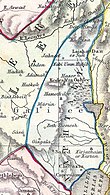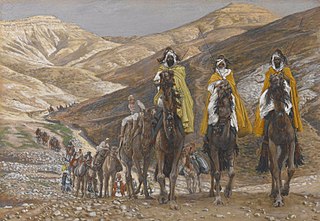
Matthew 2:1 is the first verse of the second chapter of the Gospel of Matthew in the New Testament. The previous verse ends with Jesus being named by his father. This verse marks the clear start of a new narrative, although the use of a quotation from Isaiah 7:14 in Matthew 1:23 is also reflected in the use of four Old Testament quotations in chapter 2 and the Greek: δέ in the opening words of this verse creates a continuative effect, leading directly on from the birth of the child to another connected history.

Matthew 2:10 is the tenth verse of the second chapter of the Gospel of Matthew in the New Testament. The magi, dispatched by King Herod, have been shown the location of the infant Jesus by the Star of Bethlehem. In this verse they react to this.
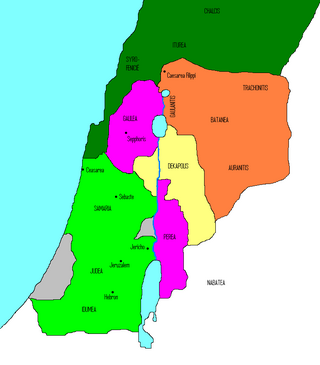
Matthew 2:22 is the twenty-second verse of the second chapter of the Gospel of Matthew in the New Testament. The young Jesus and the Holy Family have just left Egypt after hearing of the death of King Herod.
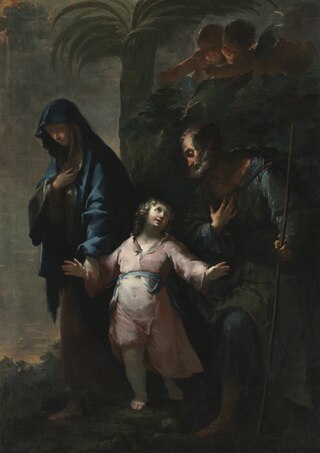
Matthew 2:23 is the twenty-third verse of the second chapter of the Gospel of Matthew in the New Testament. The young Jesus and the Holy Family have just returned from Egypt and in this verse are said to settle in Nazareth. This is the final verse of Matthew's infancy narrative.

Matthew 3:3 is the third verse of the third chapter of the Gospel of Matthew in the New Testament. The verse occurs in the section introducing John the Baptist, and links him to messianic prophecies.

Matthew 3:13 is the thirteenth verse of the third chapter of the Gospel of Matthew in the New Testament. The verse introduces the section describing the baptism of Jesus by John the Baptist.
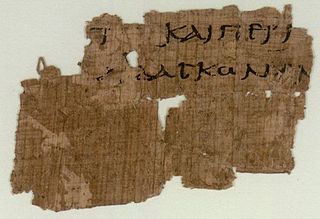
Matthew 4 is the fourth chapter of the Gospel of Matthew in the New Testament of Christian Bible. Many translations of the gospel and biblical commentaries separate the first section of chapter 4 from the remaining sections, which deal with Jesus' first public preaching and the gathering of his first disciples.
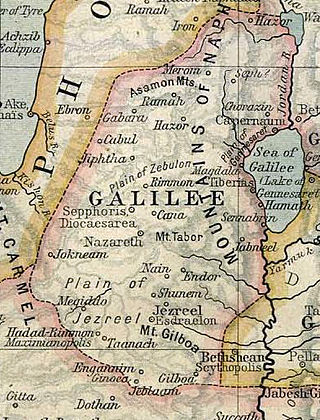
Matthew 4:14–15 are the fourteenth and fifteenth verses of the fourth chapter of the Gospel of Matthew in the New Testament. In the previous verses Jesus returned to Galilee after hearing of the arrest of John the Baptist and then left Nazareth for Capernaum. These introduce and then contain the first portion of a quote from the Book of Isaiah showing how these movements were preordained by scripture.

Matthew 4:16 is the sixteenth verse of the fourth chapter of the Gospel of Matthew in the New Testament. In the previous verses Jesus returned to Galilee after hearing of the arrest of John the Baptist and then left Nazareth for Capernaum. This verse contains the second half of a quote from the Book of Isaiah, implying that these movements were preordained by scripture.

Matthew 4:18 is the eighteenth verse of the fourth chapter of the Gospel of Matthew in the New Testament. Jesus has just begun preaching in Galilee. In this verse he encounters the first of his disciples.

Matthew 4:24 is the twenty-fourth verse of the fourth chapter of the Gospel of Matthew in the New Testament. This verse is part of a brief summary of and introduction to Jesus' ministry in Galilee, which will be recounted in the next several chapters. This verse relates Jesus' fame "throughout all Syria" and summarizes his work of healing.

Matthew 4:25 is the twenty-fifth, and final, verse of the fourth chapter of the Gospel of Matthew in the New Testament. This verse is part of a brief summary of and introduction to Jesus' ministry in Galilee, which will be recounted in the next several chapters. This verse lists the many locations from which people came to see Jesus.

Matthew 5:1 and Matthew 5:2 are the first two verses of the fifth chapter of the Gospel of Matthew in the New Testament. The verses introduce the Sermon on the Mount that will be recited in the next several chapters. The previous chapter concluded with large crowds "from Galilee, and from the Decapolis, Jerusalem, Judea, and beyond the Jordan" who followed Jesus to witness him healing: these verses present Jesus as seeing the crowds and going up onto a mountain to begin teaching.

Mark 6 is the sixth chapter of the Gospel of Mark in the New Testament of the Christian Bible. In this chapter, Jesus goes to Nazareth and experiences rejection by his own family. He then sends his Apostles in pairs to various cities in the region, where they might also face rejection. Finally, Jesus goes back to the Sea of Galilee and performs some of his most famous miracles, including the feeding of the 5000 and walking on water. This chapter also gives an account of the murder of John the Baptist.

Luke 4 is the fourth chapter of the Gospel of Luke in the New Testament of the Christian Bible, traditionally attributed to Luke the Evangelist, a companion of Paul the Apostle on his missionary journeys. This chapter details Jesus' three temptations, the start of his "Galilean Ministry", and his rejection at Nazareth, which Luke contrasts with his acclaim in nearby Capernaum.
Matthew 9:10 is a verse in the ninth chapter of the Gospel of Matthew in the New Testament.

Matthew 10:1 is the first verse of the tenth chapter of the Gospel of Matthew in the New Testament. In this verse Jesus gathers his disciples and grants them healing powers in what is known as the commissioning the twelve apostles.

Matthew 8:5 is the fifth verse of the eighth chapter of the Gospel of Matthew in the New Testament. This verse begins the miracle story in which a centurion's servant is healed, the second of a series of miracles reported in Matthew.

Matthew 10:5 is the fifth verse in the tenth chapter of the Gospel of Matthew in the New Testament.
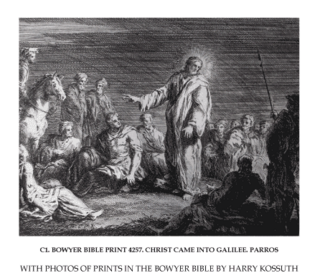
The Return of Jesus to Galilee is an episode in the life of Jesus which appears in three of the Canonical Gospels: Matthew 4:12, Mark 1:14 and John 4:1–3, 4:43–45. It relates the return of Jesus to Galilee upon the imprisonment of John the Baptist.



